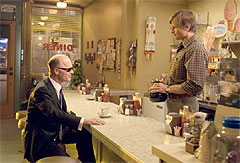
| HOME |
| NERVE |
| REVIEWS |
| ARCHIVE |
| EVENTS |
| LINKS |
| ABOUT US |
| CONTRIBUTORS |
| BACK ISSUES |
| CONTACT US |
 A
History of Violence (18)
A
History of Violence (18)
Directed by David Cronenberg, written by Josh Wagner and Vince Locke
(graphic novel) and Josh Olson
On general release from Sept 30th 2005
Reviewed by Tim Kopp
As a study of people's capability for violence and how it can transform their lives, David Cronenberg's new film stays too much on the surface to break new ground. Still, it is a testament to the craftsmanship of Cronenberg, his crew and the efforts of the exceptional cast that A History of Violence is a fine thriler with some of the year's most lingering scenes. **** out of five
A popular and well-respected man in the community of Millbrook, Tom Stall lives a contented life with his lawyer wife Edie and their two children Jack and Sarah. There are early signs that the idyll won't last: Sarah has nightmares and Jack is bullied by envious classmates at school. Things come to a head when two thugs enter Tom's diner and threaten his staff and customers. In self-defence, Tom kills both men and becomes a celebrated hero in the community and the focus of attention in the local media. His family is thrown into further turmoil when three sinister men arrive in town and challenge Tom to confess that, as they believe, his true identity is that of Joey Cusack.
A History of Violence is, first and foremost, a bravura exercise in filmmaking: cinematographer Peter Suschitzky films the heated argument between two men outside a motel with such subtlety that we don't notice the long uninterrupted take until Cronenberg makes the first real cut to build up the scene's shocking twist. The opening's deliberate pace and the effective use of amplified sound achieve a palpable sense of dread and unease that establishes the film's tone: the heightened realism discourages us from trusting the apparent normality and tranquillity, and the contrast between the idyllic small-town facade and the dark secrets underneath defines the whole picture.
This is familiar territory but what makes A History of Violence an engaging film is Cronenberg's handling of the material. He defines each character by how they react to the situation in which they are placed prior to and after Tom's self-defence killing: Tom and Edie are as yet untroubled and a loving, trusting couple who have playful sex while their son Jack uses his wit to get himself out of trouble. The film later recalls both scenes to disturbing effect when Jack viciously beats up his bullies, and the couple, angry, hurt and confused, have violent sex on the staircase. The school fight is particularly startling as Cronenberg directs it like an action film in which Jack's sudden outburst appears almost supernatural: of course, it links Jack with Tom, but it also reminds us how we have been conditioned by Hollywood films to rejoice in their violence. The shots of bloodied and heavily disfigured faces for which Cronenberg became famous are soberingly effective and they render the debate over whether the director has gone mainstream irrelevant.
Josh Olson's script is solid but too broad in its message, saying nothing about violence and its impact that hasn't been covered in other films to equal or stronger effect. Arguably, the film also has not many scenarios to explore once Fogarty has started questioning Tom's identity. That it retains its grip on us is due to Cronenberg's directorial skills and his exemplary cast: Viggo Mortensen is perfectly chosen as the family man whose past is getting scrutinised, and in his best moments, Mortensen is remarkably expressive. Maria Bello is equally strong in a character role that is more complex than it appears to be, and Ed Harris, whose last few performances have been extremely variable, is distinctly creepy as the scarred hitman. William Hurt has a bizarre but superbly performed and very amusing cameo that gives the brutal third act a light touch.
The film ends with a scene that is simply magnificent in its execution and impact: in a prolonged, wordless moment, the film relies solely on its images, a gesture, a look, and the music (a moving, understated cue in an otherwise obtrusive score from Howard Shore) to bring the story to its ambiguous, uncertain conclusion.
Printer friendly page